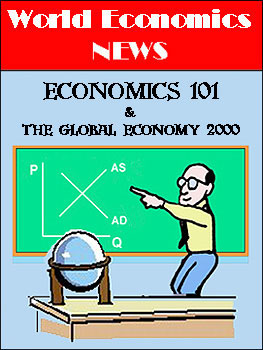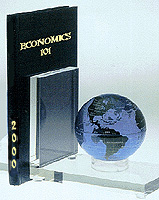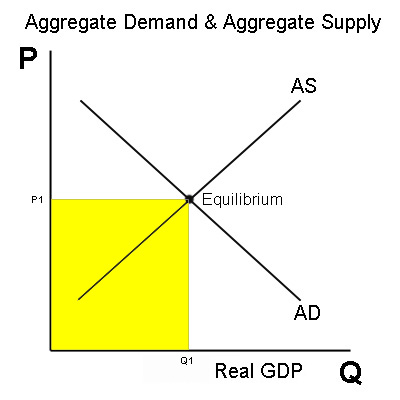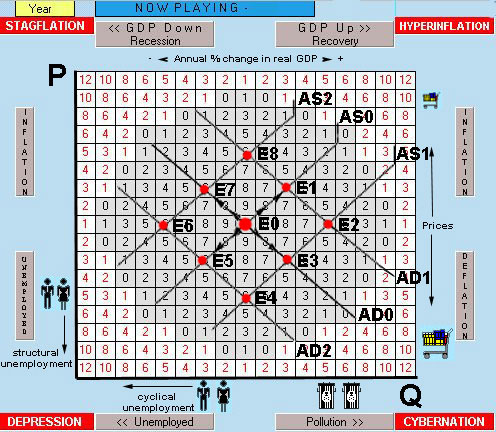 September
2, 2000 This month thousands of students will begin attending
economics
classes at high schools, colleges, and universities around the
world.
For some of these students it will be the first time they have ever
been
exposed to the rigors of formal economics instruction. They will
likely be enrolled in Economics 101 -- Principles of Economics.
Others
will be in their second or higher year of course work. Those
students
will be taking upper division theory and advanced courses in various
fields
of specialization such as money and banking, international trade and
finance,
and environmental economics. A much smaller number of students
will
have made it to graduate school in economics, business, or
international
relations. Some of those students will be teaching assistants
(helping
younger students learn the principles) or research assistants (helping
their professors with publishing projects).
September
2, 2000 This month thousands of students will begin attending
economics
classes at high schools, colleges, and universities around the
world.
For some of these students it will be the first time they have ever
been
exposed to the rigors of formal economics instruction. They will
likely be enrolled in Economics 101 -- Principles of Economics.
Others
will be in their second or higher year of course work. Those
students
will be taking upper division theory and advanced courses in various
fields
of specialization such as money and banking, international trade and
finance,
and environmental economics. A much smaller number of students
will
have made it to graduate school in economics, business, or
international
relations. Some of those students will be teaching assistants
(helping
younger students learn the principles) or research assistants (helping
their professors with publishing projects).
Economics has recently become a more common major of study among
college
students. Two years ago The Wall Street Journal published
Tristan Mabry's article focusing on the growing popularity of economics
at leading colleges and universities in the United States.
According
to the article, "The dismal science is in vogue again on
campus.
After years of trailing history, English and biology as the top
undergraduate
major, economics is enjoying a surge in popularity with college
students,
especially at the nation's most elite institutions. Economics,
once
considered one of the more difficult subjects to grasp, is the top
major
at Harvard, Princeton, Columbia, Stanford and the Universities of
Pennsylvania
and Chicago; second at Brown, Yale and the University of California at
Berkeley; and third at Cornell and Dartmouth."
What accounts for the increasing interest in a discipline that is
notorious
for causing anxiety, depression, and nausea with its bewildering maze
of
analytical axioms, esoteric blends of science and philosophy, and heavy
reliance of quantitative methods? According to the article, one
reason
appears to be global prosperity. Contemporary students are
focused
on their careers. They rank a good job and high future income as
the main reasons for attending college; and they perceive
economics
to be a good vehicle toward those ends. When Main Streets and
Wall
Streets around the world are thriving, globally oriented companies hire
more economists. The average starting salary for graduating
economics
majors at one of these companies is just over US $35,000. That
figure
is higher than most other undergraduate majors, and starting salaries
are
higher for those with Masters degrees and Ph.D.'s.
Economics is also perceived as an excellent undergraduate major for
someone pursuing a post-graduate law degree. "Of all the majors,
economics ranks in the top four or five consistently year after year
for
both applicants and offers made," said Edward Tom, director of
admissions
at the University of California at Berkeley's Boalt law school, to the
Journal's
reporter Mabry. "Logical reasoning and analytical skills are
critical
to legal studies," added Tom. Not surprisingly, economics majors
average the highest ranking score of 155 out of a possible 180 on the
Law
School Admissions Test (LSAT).
Another more subtle reason for the growing popularity of economics
is
the end of the Cold War. "Now that the Cold War is over," stated
Yale University Professor Merton Peck, "Economic issues become the
central
core of policy debates." Students are no longer focused on the
ideological
polemic of communism versus capitalism. These days they debate
the
efficacy of fixed versus variable exchange rate systems. Domestic
fiscal policy, government debt, the role of central banks, and trade
issues
are the main topics of discussion over coffee at university
cafeterias.
Also, environmental issues are very much on the minds of young people,
and economics has much to say about how to improve air and water
quality,
protect endangered species, and preserve wilderness regions.
A third reason that economics has become more popular among students
is that its importance and power to explain events is more commonly
understood
than it used to be. The famous British economist John Maynard
Keynes
is often quoted from his landmark book, The General Theory of
Employment,
Interest, and Money (1936): "The ideas of economists
and
political philosophers, both when they are right and when they are
wrong,
are more powerful than is commonly understood. Indeed, the world
is ruled by little else. Practical men, who believe themselves to
be quite exempt from any intellectual influences, are usually the
slaves
of some defunct economist." Sixty four years later the secret is
out. "Increasingly, economic issues are presented to citizens as
an important determinant of how their life is going to play out,"
Professor Michael K. Salemi, chairman of the economics department at
the
University of North Carolina, is quoted in The Wall Street Journal article.
Economics is now considered to be a core subject at most high
schools.
It's no longer a secret to young people that economic events and
policies
are powerful forces in shaping the course of human destiny.
Increasingly
more high school students have already taken some economics before they
enter college. For these reasons today's first year college
students
are less intimidated by economics than they are intrigued by it.
They have a genuine thirst to learn more about how the economy works
and
the institutions which monitor and strive to steer it.
 The freshman or sophomore
students taking Economics 101 at colleges and
universities in the academic year 2000/2001 will be learning more about
the global economy than their predecessors. Greater
emphasis is being placed on the world economy, because global economic
integration has become an important determinant of the macroeconomic
performance
of nations. More and more nations around the world are
opening
their economies to international trade, diversifying their export base,
and attracting foreign investment. The foreign trade sector is
now
the fastest growing segment of most economies. Within any given
country,
the financial health of its companies and the job security of their
workers
are increasingly dependent upon foreign sources for inputs and foreign
sales for revenues. Consumers are purchasing imports and
traveling
internationally more than ever before.
The freshman or sophomore
students taking Economics 101 at colleges and
universities in the academic year 2000/2001 will be learning more about
the global economy than their predecessors. Greater
emphasis is being placed on the world economy, because global economic
integration has become an important determinant of the macroeconomic
performance
of nations. More and more nations around the world are
opening
their economies to international trade, diversifying their export base,
and attracting foreign investment. The foreign trade sector is
now
the fastest growing segment of most economies. Within any given
country,
the financial health of its companies and the job security of their
workers
are increasingly dependent upon foreign sources for inputs and foreign
sales for revenues. Consumers are purchasing imports and
traveling
internationally more than ever before.
According to Michael Mussa, Economic Counselor and Director of
Research
IMF, "Global economic integration is not a new phenomenon."
However,
"The degree of economic integration among different societies around
the
world has generally been rising. Indeed, during the past half
century,
the pace of economic globalization has been particularly rapid.
And,
with the exception of human migration, global economic integration
today
is greater than it ever has been and is likely to deepen going
forward."
In his paper presented on August 25 in Jackson Hole, Wyoming at the
international symposium on "Global Opportunities and Challenges," Mr.
Mussa
identified three fundamental factors that are driving economic
globalization
The first is cost reducing improvements in the technology of
transportation
and communication. Secondly, the tastes of individuals and
societies
have generally favored taking advantage of the opportunities provided
by
these declining costs. Third, public policies have significantly
influenced the character and pace of economic integration. Mussa
noted that during the past 50 years of remarkable economic growth,
"World
trade in goods and services has expanded at nearly double the pace of
world
real GDP. As a result the volume of world trade in goods and
services
(the sum of both exports and imports) rose from barely one-tenth of
world
GDP in 1950 to about one-third of world GDP in 2000. By this
measure
-- and by others as well -- there has indeed been an increase in the
degree
of global economic integration through trade in goods and services
during
the past half century."
Globalization is controversial. Not everyone views the growing
trend toward greater international economic integration as a positive
development.
Anti-globalists perceive international institutions such as the World
Trade
Organization, the International Monetary Fund, and the World Bank as
one-world
entities that place business priorities over human rights, labor
standards,
and environmental protection. Technologically driven
globalization
is an engine of growth and creates many new opportunities, but it
displaces
relatively inefficient firms and their workers in the process; and it
causes
environmental and social upheaval. These unintended consequences of
progress,
heightened global competition, and greater efficiency are at the crux
of
the controversy.
At the same symposium in Wyoming where Mr. Mussa presented his
paper,
Alan Greenspan, Chairman of the Federal Reserve Board of Governors,
addressed
the issue in his remarks: "Globalization as most economists
understand
it involves the increasing interaction of national economic
systems.
Of necessity, these systems are reasonably compatible and, in at least
some important respects, market oriented. Certainly,
market-directed
capitalism has become the paradigm for most of the world, as
central-planning
regimes have fallen into disfavor since their undisputed failures
around
the world in the four decades following World War II. But there
remains
an active intellectual debate over the elements of capitalism that are
perceived as most essential for a productive and civil society. . . .
.
The conceptual battleground has moved far from the stark terms of the
earlier
capitalist-socialist confrontations. . . . . The debate has now
shifted
to the nature and extent of actions appropriate for governments to take
in order to ameliorate some of the less desirable characteristics that
are perceived to accompany unfettered competition."
This year's crop of Economics 101 students will have the opportunity
to participate in this emerging debate for the new millennium.
The
key analytical model they will use to analyze the performance of market
oriented economies in a global context is that of Aggregate Demand and
Aggregate Supply. The AD-AS model is included as one or more
chapters
in virtually every leading introductory textbook. It is displayed
by a diagram which measures a given country's price level on the
vertical
axis and real GDP on the horizontal axis. Aggregate Demand (AD)
is
comprised of consumer spending, business investment, government
purchases,
and net exports; it is inversely related to the general price
level.
Simply put, people will buy more quantity (Q) at lower prices (P), all
other things held constant. Aggregate Supply (AS), on the other
hand,
is directly related to the general price level. Simply
put,
business firms will supply more at higher prices. (See Diagram Below).

Market oriented economies will naturally seek the equilibrium level
of output and prices (where the AD and AS lines cross). Nominal
GDP
(P1xQ1) is shown by the yellow shaded area. If AD were to
increase
(or decrease), the AD curve would shift outward (or inward).
Nominal
GDP would rise (and fall) accordingly. So would the real GDP, but
not by as much because real GDP measures output at constant (base year)
prices. Fiscal, trade, and monetary polices are used by
governments
on the margin to find an acceptable level of real GDP near full
employment
without too much inflation or too much pollution. This becomes
more
apparent when we superimpose the AD-AS model on the playing field of The
Global Economics Game.

The image above displays the AD-AS model superimposed on the playing
field of The Global Economics Game. Each square in
the playing field represents a given country's macroeconomic
performance.
Moving from left to right indicates faster economic growth.
Moving
up the playing field indicates higher prices. Cyclical
unemployment
rises and falls inversely with growth; when GDP increases, cyclical
unemployment
falls and vice versa. However, structural unemployment can be
caused
by increases in aggregate supply (from AS0 to AS1); and excessive
unbridled
growth can cause too much pollution (E2). Because economics
involves
trade-offs and conflicting goals, economic policy is constantly
striving
for an optimal mix of output, unemployment, prices, and
pollution.
That optimal mix is assumed to be the very center square of the playing
field (E0). Moving away from the center square results in lower
scores.
The red numbered zones in the corners indicate negative scores and are
highly undesirable.
For example, contrived commodity shortages, natural disasters, and
labor
strikes can reduce Aggregate Supply (from AS0 to AS2) so that an
economy
would move from E0 to E7 toward stagflation. On the other
hand, cost saving technological breakthroughs and greater competition
from
freer trade have the effect of increasing AS so that an economy would
move
toward E3 and the cybernation corner. A deficiency in
Aggregate
Demand (AD) would drive an economy in the direction of E5 and depression
in the lower left corner. Excessive AD would move an economy in
the
opposite direction diagonally toward E1 and hyperinflation in
the
upper right corner.
Returning to the issue of globalization, the trade-offs are apparent
from the playing field's matrix. The benefits derived from
technologically
driven globalization are lower prices, more output, and greater
efficiency.
[An economy moves diagonally downward toward the lower right corner of
the playing field]. However, the costs are structurally displaced
workers, the social disharmony caused by greater income inequality, and
the damage done to the environment where external costs are unaccounted
for. If the public perceives that the economy is moving too far
diagonally
down or too rapidly to the right on the playing field, then they will
call
for public policy measures to reverse the trend. Trade
restrictions
and environmental regulations can be used to do this. Economics
101
teaches that it makes more sense to subsidize and re-train workers who
have been displaced by market driven changing patterns of trade.
However, it also teaches that it makes perfectly good sense to use supply-side
regulatory policies to thwart growth if its costs to the environment
are
exceeding its benefits on the margin. (Technically, this is
called
internalizing an externality). The objective is to equate
marginal
benefit and marginal cost.
The marginal benefit equal to marginal cost principle also applies
to
demand-side
macroeconomic policy. Students taking Economics 101 this year
will
begin to understand why central banks in the industrialized world have
recently been using monetary policy to tighten credit and raise
interest
rates (See Table Below). The perceived enemy is potential future
inflation. Strong aggregate demand can generate economic
expansion,
but excessive aggregate demand can cause inflation. When central
bank policy makers are convinced that the costs of future inflation
will
exceed the benefits of cyclical expansion, they will implement a
restrictive monetary policy to curtail aggregate demand. Higher
interest
rates make it more difficult for consumers and businesses to borrow and
spend.
Interest Rates: 3-month money market (annual
percent)
|
Country
|
08/23/00
|
Year Ago
|
 Australia Australia |
6.53
|
4.93
|
 Britain
Britain |
6.11
|
5.22
|
 Canada Canada |
5.62
|
4.69
|
 Denmark Denmark |
5.70
|
3.10
|
 Japan Japan |
0.30
|
0.03
|
 Sweden Sweden |
3.92
|
3.04
|
 Switzerland Switzerland |
3.48
|
1.12
|
 United States United States |
6.50
|
5.30
|
 E-11
E-11 |
5.04
|
2.59
|
Source: The Economist (August 26th -
September
1st 2000)
Market oriented economies are notorious for their unpredictability,
instability, and cyclical fluctuations. The myriad of forces
driving
aggregate demand and aggregate supply are constantly in flux.
Well
intended macroeconomic policy measures run the risk of being ill-timed
-- either too little and too late or too much and too soon. An
overly
restrictive monetary policy, for example, has the potential to
precipitate
a recession. Increased globalization adds still another dimension
of uncertainty to the equation. Monitoring
the macroeconomic performance of nations, evaluating the soundness of
fiscal,
trade, and monetary policies, and balancing conflicting goals in a
global
setting are the core topics of modern economics that will mystify and
engage
this year's students.
It is indeed a fascinating subject. Those of us who have
chosen
economics for our careers never seem to become bored by it,
because
it perpetually addresses the most important social, business, and
personal
issues of the day. In that sense Economics 101 doesn't change
over
time -- only the issues do. Most of the students taking Economics
101 in the year 2000 will derive a great deal of benefit from the
experience.
Even though it will cost them time and money, the most important
economic axiom they will learn is that anything is worth doing if the
benefits
exceed or are equal to the costs.
Sources and Recommended Links:
Mabry, Tristan. "Economics Enjoys a Bull Run at Colleges." (The
Wall
Street Journal, November 30, 1998).
Mussa,
Michael. "Factors Driving Global Economic Integration." August 25, 2000)
The
Federal Reserve Board. "Remarks by Chairman Alan Greenspan." (August
25,
2000)
Return
to Home Page Return
to World Economics News
The Global Economics Game (C)
2000
Ronald W. Schuelke All Rights Reserved
 The freshman or sophomore
students taking Economics 101 at colleges and
universities in the academic year 2000/2001 will be learning more about
the global economy than their predecessors. Greater
emphasis is being placed on the world economy, because global economic
integration has become an important determinant of the macroeconomic
performance
of nations. More and more nations around the world are
opening
their economies to international trade, diversifying their export base,
and attracting foreign investment. The foreign trade sector is
now
the fastest growing segment of most economies. Within any given
country,
the financial health of its companies and the job security of their
workers
are increasingly dependent upon foreign sources for inputs and foreign
sales for revenues. Consumers are purchasing imports and
traveling
internationally more than ever before.
The freshman or sophomore
students taking Economics 101 at colleges and
universities in the academic year 2000/2001 will be learning more about
the global economy than their predecessors. Greater
emphasis is being placed on the world economy, because global economic
integration has become an important determinant of the macroeconomic
performance
of nations. More and more nations around the world are
opening
their economies to international trade, diversifying their export base,
and attracting foreign investment. The foreign trade sector is
now
the fastest growing segment of most economies. Within any given
country,
the financial health of its companies and the job security of their
workers
are increasingly dependent upon foreign sources for inputs and foreign
sales for revenues. Consumers are purchasing imports and
traveling
internationally more than ever before.
 September
2, 2000 This month thousands of students will begin attending
economics
classes at high schools, colleges, and universities around the
world.
For some of these students it will be the first time they have ever
been
exposed to the rigors of formal economics instruction. They will
likely be enrolled in Economics 101 -- Principles of Economics.
Others
will be in their second or higher year of course work. Those
students
will be taking upper division theory and advanced courses in various
fields
of specialization such as money and banking, international trade and
finance,
and environmental economics. A much smaller number of students
will
have made it to graduate school in economics, business, or
international
relations. Some of those students will be teaching assistants
(helping
younger students learn the principles) or research assistants (helping
their professors with publishing projects).
September
2, 2000 This month thousands of students will begin attending
economics
classes at high schools, colleges, and universities around the
world.
For some of these students it will be the first time they have ever
been
exposed to the rigors of formal economics instruction. They will
likely be enrolled in Economics 101 -- Principles of Economics.
Others
will be in their second or higher year of course work. Those
students
will be taking upper division theory and advanced courses in various
fields
of specialization such as money and banking, international trade and
finance,
and environmental economics. A much smaller number of students
will
have made it to graduate school in economics, business, or
international
relations. Some of those students will be teaching assistants
(helping
younger students learn the principles) or research assistants (helping
their professors with publishing projects).